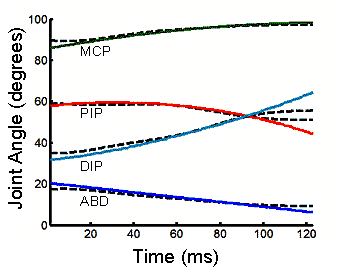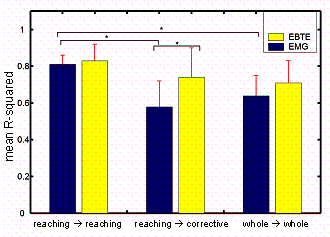
As humans, our hands have evolved not only to grip and manipulate objects, but also to communicate and interact with our environment. Any hand disability leads to social and emotional distress and often severely interferes with activities at work, leisure, sport, and the arts. Neural-based prosthetic control is emerging as a viable method in restoring function to such patients by utilizing normal neural signals to control a mechanical device, thereby circumventing physical deficits.
Current approaches to the development of a neurally-controlled prosthetic hand have been limited due to a lack of understanding of the relationship between neural signals and dynamic finger movements. In our current work, we establish this relationship for the index finger.
 Joint angle predictions of a neural network based on EBTE. MCP = metacarpophalangeal joint flexion, ABD = metacarpophalangeal joint abduction, DIP = distal interphalangeal joint, PIP = proximal interphalangeal joint. |
The neural input to all the muscles controlling the index finger (EMG) and finger position are simultaneously measured. The neural signal is converted to a torque estimate using biological constraints of the muscles. Finally, an artificial neural network is trained to dynamically predict position from the torque estimate. |
| The performance of the EMG network was statistically poorer (p<0.05) in conditions 2 and 3 than on condition 1. Furthermore, the EBTE network performed statistically better than the normalized EMG network in condition 2. Our results show that index finger position can, indeed, be predicted from the neural input to the muscles (mean R2 = 0.81). Furthermore, the EMG based torque estimate (EBTE) was a better predictor of index finger position than EMG alone; the EBTE prediction was accurate independent of the movement, while the EMG prediction was accurate only for movements under which it was trained. |  Performance of EBTE network versus EMG network under three testing conditions. The performance of the EBTE network was not statistically different in any of the testing conditions: 1) trained on reaching phase, tested on reaching phase 2) trained on reaching phase, tested on corrective phase, 3) trained on whole trial and tested on whole trial. |
We have demonstrated the first mapping between neural input to muscles and their associated joint angles in a dynamic movement task. In addition, we have demonstrated the effectiveness of calculating a muscle cocontraction independent quantity, EBTE, in predicting index finger posture under different movement conditions.
past head
- Yoky Matsuoka
past staff
- Pedram Afshar
past contact
- Yoky Matsuoka